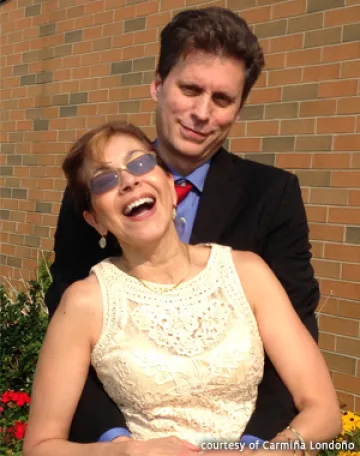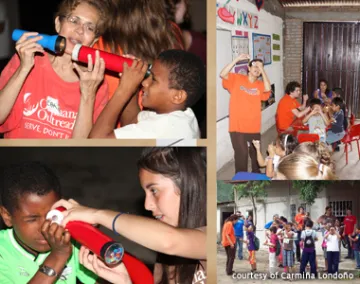Etendue: Carmiña Londoño

Welcome to Etendue, featuring interesting and accomplished individuals known for their leadership and contributions both with their careers and the College of Optical Sciences, in their own words. (For a similar view on the college’s best and brightest – our students – please check out Another Wavelength among our Students in the Spotlight.)
This month, we hear from Carmiña Londoño, Ph.D. (OSC M.S. 1982).
Where are you from?
I was born in Colombia, South America, and came to the U.S. with my family when I was 13 years old. We grew up in Lowell, Massachusetts. My parents placed great emphasis on education. They wanted my sisters and me to have careers that would allow us to support ourselves and be independent women. They used to say that the knowledge we put in our heads was ours, and no one could take that away. Even though my parents were not engineers, they believed that through engineering they could offer their daughters the best possible chance for a successful future. All three of us became engineers. I received my B.S. in physics at the University of Lowell, then I obtained my M.S. degree at the Optical Sciences Center and later I earned my Ph.D. in electro-optics at Tufts University.
Who or what influenced your interest in optics?
In high school, my older sister and I competed in science fairs for three consecutive years. We were always competing against each other for first or second place. One year I even made it to the regional competition with a project about the dynamics of binary stars. I had an interest in astronomy but what I really wanted was to be an astronaut. When we were teenagers, my parents took us to the Kennedy Space Center, and I remember really wanting to join the space program. However, I quickly realized that having severe asthma with chronic respiratory infections (among other limitations) was likely going to make that dream very difficult. Then, in my junior year of college, I took an optics class that was really fascinating and interesting to me. At the same time, my mother (being the practical woman she was and continues to be) kept asking what kind of a job I expected to get with just a B.S. in physics. In response, I read more avidly about careers in optics, took more optics classes as part of my physics degree and got summer and part-time jobs that exposed me to the possibilities of optics. I worked a couple of summers at Itek Corp. in Lexington, Massachusetts, where I had the opportunity to work with many outstanding optical engineers such as Mark Kahan, who was my supervisor. I worked on the design of ultra-lightweight mirror substrates and the degradation of image quality due to intercellular deflections. All in all, my time at Itek was a first-rate experience that gave me a solid exposure to the world of satellite systems, but more importantly it gave me a real appreciation of how exciting optics could be as a career.

Describe your career.
After getting my M.S. degree in 1982, I came back to Massachusetts to work at the Avco-Everett Research Laboratory as a lens designer. The mid-1980s was the time of the Strategic Defense Initiative, and Avco was at the forefront of some very interesting and state-of-the-art laser research. Under the excellent tutelage of Ralph Berggren, I was tasked with the optical design of diffraction-limited resonators for two high-energy excimer lasers. I was a young and enthusiastic optical engineer to whom Ralph gave major responsibilities. I worked closely with a team of technicians who helped me assemble, test and align the optomechanical laser systems and develop the optical diagnostics to evaluate the beam quality of the excimer lasers. We demonstrated that high-energy excimer lasers could deliver diffraction-limited performance, which was of essential importance to the success of any laser-based defense system.
After Avco, I worked at the Polaroid optical engineering division led by William Plummer. We designed and tested novel optical systems for medical applications, consumer products (cameras, barcode scanners, CD players) and large-quantity molded optical elements for original equipment manufacturers.
With Peter Clark, who is one of the most creative lens designers that I have worked with, we designed and tested a medical prototype that produced 8-by-10-inch instant-dry monochrome transparencies on a Polaroid proprietary and unique high-resolution binary film for ultrasound and X-ray applications. We designed the optics for an optical printer that wrote digital half-tone images with four multimode diode lasers and were awarded a patent for the design. Polaroid successfully manufactured several prototypes and eventually teamed up with another company (Hughes-Leitz in Canada) for actual production.
Sponsored by my employer and under the excellent guidance of William Plummer from Polaroid and Robert Gonsalves from Tufts, I earned a Ph.D. in electro-optics at Tufts University. My research focused on the mathematical modeling, design and fabrication of diffractive optical elements for optical athermalization and achromatization. The idea was to compensate for the focus shift and aberration degradation caused by temperature variations of polymethyl methracrylate lenses by appropriately combining a conventional refractive element with a surface-relief optical component. We received a U.S. patent for this work, and Polaroid subsequently incorporated this technology in a consumer camera.
Then my career took an interesting turn. I applied for and won an American Institute of Physics Congressional Science Fellowship and served as a technical advisor in 1994 for the U.S. House of Representatives Committee on Science, Space and Technology. I worked with congressional members and their staff, government agencies, and concerned groups on several science, technology and trade policy issues. My direct supervisor was Jim Turner, a sharp lawyer with a critical engineering mind, who gave me the opportunity to experience a fun year with many eye-opening opportunities, especially for a lens designer. After my year on the Hill, I was recruited by the National Institute of Standards and Technology. After several years I became the group leader of the Global Standards and Information Group responsible for several key activities, including the Standards in Trade workshop program, through which we brought international experts to learn about the U.S. standardization, metrology and conformity assessment system and to adopt practices that would open markets for the U.S. During my tenure at NIST we successfully conducted over 65 workshops for 35 countries, for a total of approximately 2,000 foreign participants. NIST gave me the opportunity to travel extensively, visiting national metrology labs and standards bodies in about 27 countries. My years at NIST were an excellent experience that taught me much about building technical infrastructure at a global scale and facilitating the creation of export markets.
Describe your current job.
After 13 year at NIST, I moved to the National Science Foundation. First I worked at the NSF Office of International Science and Engineering, having main responsibility for the evaluation, review and funding of proposals that involved international collaborations with Latin America. Then, three years ago, I became a Program Director for the Engineering Research Centers program, where I have primary responsibility for the review and management of four ERCs, three which are predominantly focused on the energy sector. The ERC program invests $40 million per center over 10 years on multi-institutional, interdisciplinary research teams to advance potentially transformative and precompetitive engineering ideas. The ERCs must work in partnership with industry, have a vibrant workforce-development/education component and create a culture of inclusion for all ERC participants.
Share your single best OSC experience.
Even though I was only at OSC for two years, I have many fond memories of my time in Tucson. The students, the professors, the staff, the comradery of the students and the support that I received from so many are treasures that I hold close to my heart. I am particularly grateful to Jack Gaskill, who went out of his way to help me embrace the OSC culture and encouraged me to stay in the program after a very difficult first semester. Bob Shannon was my thesis advisor. He was an excellent and patient mentor. When I was interviewing for a research assistantship in his group, I knocked a glass of water all over his desk due to my being nervous. Bob hired me anyway! I learned a lot from Bob, and I also learned to be careful with glasses full of water, especially when I went to his office for advice.
I don’t know if the day of my thesis defense was my best experience at OSC, but I remember it vividly. Facing Roland Shack, Jim Wyant and Bob Shannon, who were on my thesis committee, was truly nerve-wracking. Thank goodness, Roland broke the ice by looking at my transcript and asking me how the ballet dance class that I had taken was going to help with my thesis defense or my future career in optics. We all laughed and that interlude helped calm my nerves so that I was able to successfully defend my thesis. However, I think that even today I would be just as nervous if I were put in a room to defend anything in front of these three giants of the optics community.
Why is staying involved with OSC important to you? How are you involved?
Throughout the years, I have volunteered at science fairs, engineering festivals and career days at local high schools, where I have encouraged students to follow a career in optics and promoted OSC to literally anyone who has asked me where to study optics. Even though I am no longer engaged in lens design or optical engineering on a daily basis, I remain in awe at all the vital contributions that optics and photonics make to the betterment of our lives. I feel blessed and privileged to have had the opportunity to study at OSC when I did. I am humbled when I read about the significant advancements that my classmates have made to our field.
Name one neat fact about you.
I don’t know if this is a neat fact or not, but it is something that has brought me much fulfillment. About six years ago, my daughter and I started going on an annual volunteer vacation with an organization called Outreach360. We have gone three times to the Dominican Republic and twice to Nicaragua. We put on science/optics camps in economically disadvantaged areas where the children have no chance of getting hands-on science experiences. SPIE and OSA have both been very generous with donations and materials, which we use to demonstrate basic optics and physics concepts.

We have had many hours of fun trying to figure out optical illusions; building kaleidoscopes, telescopes, periscopes and thaumatropes and discussing how these instruments work; conducting simple experiments with prisms, diffraction gratings, mirrors and lenses; launching rockets; and doing other fun science activities. These volunteer vacations take a lot of preparation and the conditions of the places where we stay and teach are rather basic, but the children’s eagerness to learn is so evident and contagious that one quickly ignores the inconveniences and gets immersed in the creative and learning process.
[Editor’s Note: Carmina has been instrumental in the planning of OSC alumni and industry partner gatherings held in the D.C. area.]
Photos from top: Carmiña Londoño with her husband, Joe Kopanski, in 2014; Carmiña with her daughter, Lillian, doing optics outreach in the Dominican Republic and Nicaragua.
